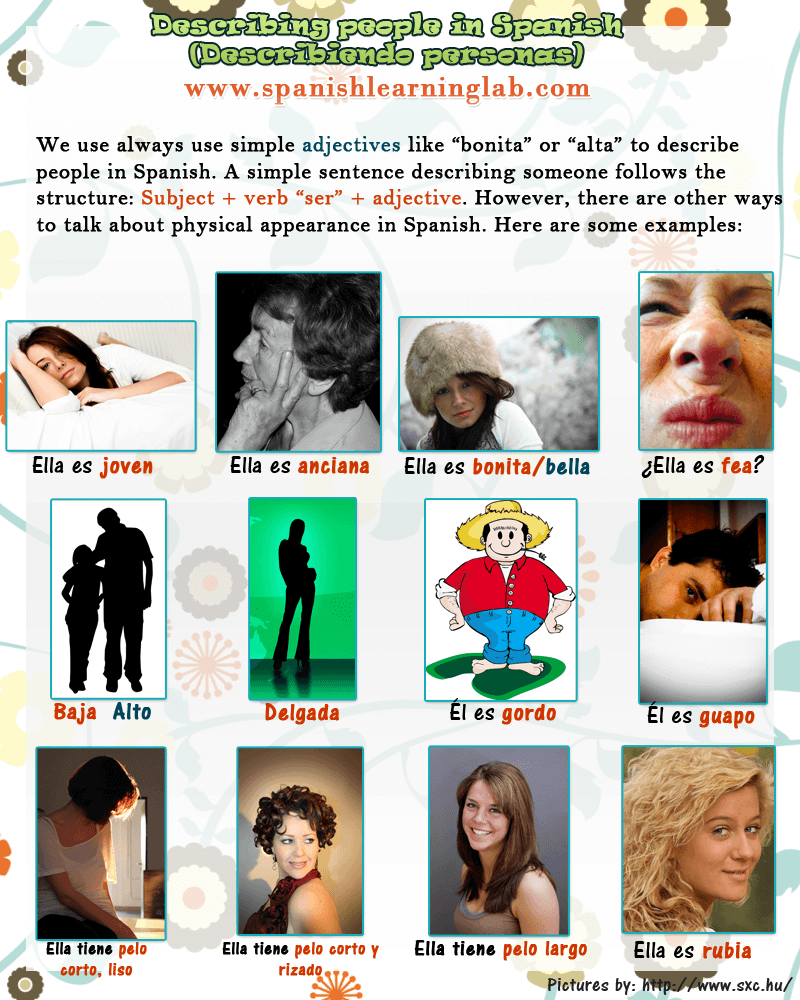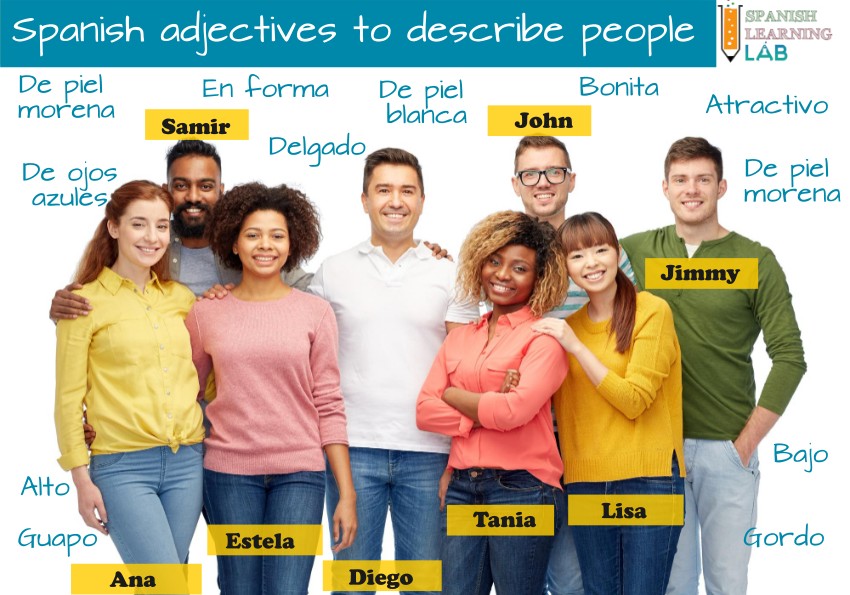Talking about physical appearance in Spanish is easy if you know a few basic verbs and some common adjectives. In this lesson, we will introduce the basic vocabulary and expressions for making physical descriptions in Spanish in a very simple way. Here, you will find many examples using the most important Spanish adjectives, nice illustrations and several interactive quizzes to practice as you progress in the lesson. Let’s start…
Essential adjectives for physical appearance in Spanish
Adjectives are words used to describe something or someone, such as JOVEN(young), BONITA (beautiful) and so on. Spanish adjectives must agree in number and gender with the noun (person or thing) they modify. The picture below shows some of the most common adjectives and verbs for talking about physical appearance in Spanish. Pay attention to where adjectives are placed in the sentences and how the verbs SER and LUCIR are used as well.

Interactive quiz No. 1
Drag these short sentences describing people in Spanish and drop them under the correct pictures based on the appearance of these characters.
Verbs and adjectives to describe people in Spanish
Ways to ask about physical appearance in Spanish
The verb SER is really useful for making physical descriptions in Spanish. SER will be commonly used in its forms ES and SON, as in questions like these:
- ¿Cómo es él/ella? – Ella es bonita. (What’s she like? – She’s pretty.)
- ¿Cómo son ellos? – Ellos son feos. (What are they like? – They are ugly)
The second verb is LUCIR (to look like), which is a little bit more formal, and will be used as “LUCE” for a person and LUCEN for several people, just like in these two examples:
- ¿Cómo luce él? – Él luce atractivo. (What does he look like? – He looks attractive.)
- ¿Cómo lucen ellos? – Ellos lucen en forma. (How do they look? – They look fit.)
Listen to the first group of examples on physical descriptions in Spanish:
|
¿Cómo es ella? – Es alta, delgada y pelirroja.
What does she look like? – She is thin, tall and has red hair
|
|
¿Cómo es el ladrón? – Es alto y tiene bigote
What does the thief look like? – He is tall and has a mustache
|
|
¿Cómo es su pelo? – Su pelo es crespo/rizado
What’s her hair like? – Her hair is curly
|
| ¿Cómo luce tu novio? – Él es gordito y bajo. What does your boyfriend look like? – He is a short, chubby guy |
|
¿Cómo luce tu novia? – Ella es bonita y tiene pelo liso.
What does your girlfriend look like? – She is pretty and has straight hair
|
|
¿Puede describirlo? – Es un hombre de mediana edad
Can you describe him? – He is a middle-aged man…
|
Interactive quiz No. 2
Drag the words to the correct spaces to complete these questions and answers about short physical descriptions in Spanish.
For some questions, it is necessary to use an article (un, una, la, los…) or a possessive adjective (su, tu, mi…) depending on who you are talking about, e.g. “¿Cómo es el ladrón?” (What does the thief look like?). Finally, you can also add direct object pronouns to the verb “describir” right after the verb, as in “¿Puedes describirla?” (Can you describe her?) and ¿Puedo describirlos? (Can I describe them?).
The structure of sentences to describe people’s appearance in Spanish
The answers to the questions above and others about physical appearance will normally use the verbs LUCIR and SER plus adjectives. Here is the sentence structure that Spanish physical descriptions will follow most of the time:
Subject (optional) + verb (Lucir/Ser) + adjective/adjectives, e.g. Ella es alta.
Generally, even if the question you are asked contains the verb LUCIR, the verb SER is the most appropriate to describe a person’s appearance because LUCIR is more suitable when making compliments than for describing the way people look. In the previous examples, we also saw some sentences related to parts of people’s bodies such as “El pelo”(hair), “Los ojos” (eyes) and so on. For that kind of Spanish physical descriptions, you can use the verb TENER and follow this structure:
Subject (optional) + TENER (conjugation) + noun + adjective, e.g. Ella tiene ojos café
Common adjectives in physical descriptions in Spanish
As you can see, it is very important to use adjectives the right way. They are always placed after the verb SER and when more than one adjective is used, we must separate them with commas and add “Y” between the last two. Here some more examples of physical descriptions in Spanish using common adjectives.
|
Carlos es un joven de 20 años.
Carlos is a 20-year-old young man
|
|
El señor López es un hombre mayor/ El señor López es anciano.
Mr. Lopez is an old man
|
|
Mi hermano es ese muchacho bajo.
My brother is that short guy
|
|
Ellas son de estatura promedio/ Ellas son de altura promedio.
They are average height
|
|
Nosotros somos delgados y saludables
We are thin/slim and healthy.
|
|
Mi abuelita tiene el pelo canoso.
My grandmother has gray hair
|
Interactive quiz No. 3
Observe the physical appearance of the people in the picture, and then select the correct answer for each question in the interactive quiz below.

The present continuous in Spanish
The last group of examples will be using the present continuous in Spanish, “estar + gerundio”. We will not go deep into the grammar stuff, but basically if a verb finishes in -AR then we will change its ending to -ANDO so a verb like USAR, for instance, will change to USANDO. Verbs that end in -ER and -IR change their ending to -IENDO so the verb VIVIR, for example, changes to VIVIENDO.
Imagine you are studying math and someone asks you ¿Qué estás haciendo? (What are you doing?). In order to reply, you may use the verb ESTUDIAR so your answer would be “Yo estoy estudiando” or just “Estoy estudiando”. Listen to a few more examples using more common words for physical appearance in Spanish like “Barba” (beard) and “Calvo”(bald).
|
¿Qué estás haciendo? – Estoy afeitándome la barba.
What are you doing? – I am shaving my beard
|
|
Estamos escribiendo una historia sobre un hombre calvo.
We are writing a story about a bald man
|
|
Ahora tengo pelo corto y estoy viviendo en otra ciudad.
Now I have short hair and I am living in another city
|
|
Estoy haciendo ejercicio porque estoy gordo.
I am exersicing because I am fat
|
|
La chica de pelo largo está estudiando matemática.
The girl with long hair is studying mathematics
|
Interactive quiz No. 4
Practice describing people’s appearance in Spanish with three exercises in the following interactive quiz.
Related PDF Worksheets:
- Adjectives for Appearance in Spanish (Vocabulary)
- Physical Appearance in Spanish (Labeling pictures)
- Describing People in Spanish
- Physical Descriptions in Spanish
- Identifying People in Spanish
- Physical Appearance in Spanish (Dialogues)
- Describing People in Spanish (Reading)
- Clothing and Physical Appearance in Spanish (Reading)
- Dialogues about the family in Spanish
- Describing Historical Figures in Spanish (Reading)
- Family Members in Spanish (Tree + Sentences)
